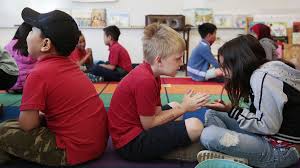
Learning Approaches, Theory, and Practice
Order Instructions:
Becoming a professional in the field of early childhood education requires you to become familiar with the various developmental theories as well as research that studies the effectiveness of various learning approaches. Throughout the last two weeks, you have learned about these different theories and approaches to learning. After engaging in discussions with your classmates, you now have ideas about which theories and approaches you would like to use in your work with children. Using the steps below, you will sort through these theories and approaches to shape who you are as a teacher and what you believe about how children learn best. This assignment will also help you prepare for your final assignment.
Prior to beginning work on this assignment, access the APA template for assistance with the writing process, formatting, documentation, and citations in your written work.
Step 1: Reflect back on your initial response in the “Aspects of Theories” discussion from Week Two and the “Learning Approaches” discussion from this week.
• Using the theories and approaches that were discussed, fill in the table below by ranking each according to how you connected with them (“most connected” at the top and “least connected” at the bottom). Be sure to delete the example row provided.
Theorists/Theories – Most connected to least connected Learning Approaches – Most connected to least connected
Ex: 1. Piaget – Theory of Cognitive Development Ex: 1. High Scope
1. 1.
2. 2.
3. 3.
4. 4.
5. 5.
6. 6.
7. 7.
8. 8.
•
Step 2: Using the table as a guide, research your top two theories and top two learning approaches. You will create a PowerPoint presentation that contains your responses to the points below as they are applied to each of your top two theories and top two learning approaches.
• Summarize the underlying principles or ideas for this theory/approach.
• Explain why this theory/approach is important to understand and how it will benefit your work with children.
• Discuss how this theory/approach will help you to be an effective teacher.
• Explain why this theory/approach is ranked at the top of your list.
• Summarize the similarities you see between the theory and model of those you ranked first. For example, if Piaget’s theory of cognitive development was your top theory and the Reggio Emilia approach was your top learning approach, share how these two ideas support one another.
Step 3: you can submit your assignment as a Power Point that contains your table from Step 1 and your responses to the questions from Step 2. Whichever option you choose, you will also need to follow APA format and include title and reference pages. In addition, the information in your assignment needs to be supported by the textbook and at least two additional scholarly sources. PowerPoint and list them on the reference pages/slides.
SAMPLE ANSWER
Learning Approaches, Theory, and Practice
| Theorists/Theories – Most connected to least connected | Learning approaches – most connected to least connected |
| 1. Skinner: Operant Conditioning Theory | Acquisition of rules |
| 2. Vygotsky: Sociocultural Theory of Development | Concept learning |
| 3. Erikson: Theory of Psychosocial Development | Stimulus/response learning |
| 4. Bandura: Social Learning Theory | Signal learning/recognition |
| 5. Piaget: Theory of Cognitive Development | Motor chain learning |
| 6. Gardner: Theory of Multiple Intelligences | Multiple discrimination |
| 7. Kohlberg: Theory of Moral Development | Problem solving |
| 8. Feud: Psychosexual Theory of Development | Verbal chain sequence |
Operant conditioning theory
The underlying idea for this theory is that external learning experiences greatly influence the behavior of a person. According to behaviorists, learning occurs through the change in behavior. Positive behavior, skill or knowledge can be achieved through reinforcement. Some examples of reinforcement for learners include the giving of stickers for good work or praising the learners in a selective manner (Krogh & Estes, 2012).
Understanding this theory is important because it helps a teacher to appreciate and utilize any form of reinforcement as well as punishment to control the behavior of students. According, I will become an effective teacher if I utilize this theory because I will learn how to get the best out of my students. This theory is ranked at the top of my list because I believe that behavior plays the most significant role in determining the outcome of a learning experience.
Socio-cultural theory of development
The basic idea presented by this theory is that an individual’s development is highly shaped by the social and cultural interactions around him/her. Thus, a learner can obtain knowledge from a teacher, another learner, or a family member. Ideally, Vygotsky’s theory exhibits some similarities with Piaget’s theory in the sense that teachers are considered to play an important role in supporting the opportunities for learners to gain knowledge with some independence (Krogh & Estes, 2012).
It is important to understand this theory because it helps a teacher to appreciate the socio-cultural aspects that influence learning (Pritchard, 2013). Accordingly, this theory will help me to be a good teacher by helping me utilize group work and partnerships with family for purposes of ensuring that students develop in the best way possible. I have ranked the socio-cultural theory as the second-most important on my list because I believe it is useful in the established of home-school partnerships. This theory is similar to the behaviorist theory in the sense that society greatly influences a child’s learning and development.
References
Krogh, S. L. & Estes, L. (2012). Pathways to Teaching Young Children: an Introduction to Early Childhood Education.
Pritchard, A. (2013). Ways of learning: Learning theories and learning styles in the classroom. Routledge.
We can write this or a similar paper for you! Simply fill the order form!




